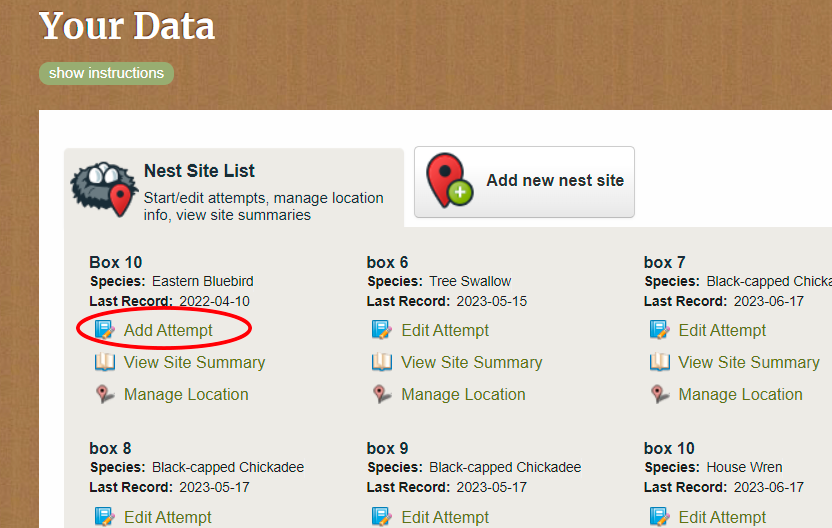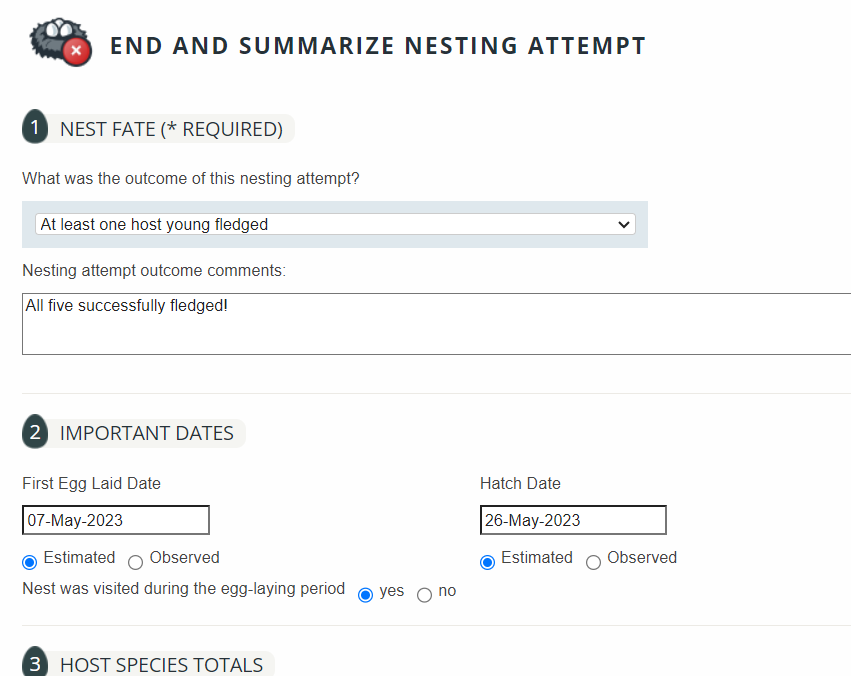AKP Partners, Welcome to NestWatch
Welcome to NestWatch! We’re here to help make the transition as easy as possible. We’ve collaborated with the American Kestrel Partnership to migrate your data into our database where it will be preserved in perpetuity for scientific use. If you’re reading this, we hope that means you have opted-in to continuing your data entry with us and have made a new account following the steps described in previous AKP emails. Now, we’ve rounded up some FAQs that we think will help explain some key similarities and differences to be aware of before the new nesting season begins!
Key differences and similarities:
- NestWatch accepts data on all birds—including invasive species—so if there is a different species nesting in your kestrel box (e.g., screech-owl, duck, starling), please report on it as you are able. This includes birds not in nest boxes as well!
- Non-native species can be recorded in the same manner as other species (and summarized with the code “invasive species management” if you have removed or managed nests/eggs/young). Please be sure of identification before taking any actions with an invasive species’ nest (they can resemble the nests and eggs of native species).
- While many variables for data collection are similar between the two programs, this quick chart highlights some (but not all) key differences.
| Variables Collected | American Kestrel Partnership | NestWatch |
| Entering nestling age | optional | not asked |
| Entering empty nest boxes | encouraged | optional |
| Estimating lay date, hatch date, and fledge date | not asked | encouraged |
| Reporting final clutch size, maximum # of hatched young, and # of fledglings | not asked | encouraged (can be 0) |
| Reporting final nest fate | not asked | required (can be unknown) |
| Uploading photos of nests | not asked | optional |
How to get started:
First, log in to your NestWatch account to view your existing data and familiarize yourself with the layout. Check that all of the nest boxes you’d expect to find are there (if any are missing, please contact us).
Before you begin entering new data into NestWatch, please take a look at our data sheet to get a quick overview of the kinds of data we collect. Please note that not every field may be applicable to your situation. Partial data is acceptable, but we recommend filling out as many data fields as possible.
Record each nest on a separate data sheet for later entry into the website. Alternatively, record data in real time using our field-ready mobile app. Please read our overview of how to enter data before you begin which includes instructions for entering data on both the NestWatch website and the mobile app.

Add a Nesting Attempt
To add an attempt to a Nest Site you have already created, open your Nest Site List (above the map). All of your Nest Sites will be listed. Choose a Nest Site and click "Add Attempt" to start entering data for a nest.

Summarizing a Nesting Attempt
When you're done entering all of the Nest Visit data for a nest, click the "Summarize this nesting attempt" button at the bottom of the page. When the Nest Summary opens, you'll see fields to report the Nest Fate, Important Dates, Host Species Totals, and any additional comments you may have about the Nesting Attempt. Click "End this nesting attempt" to save and close out of the attempt.
More details:
- Even if you’re already familiar with nest-monitoring best practices, all NestWatch participants are required to read our Code of Conduct and take a short, simple quiz to become certified to check nests. The Code of Conduct helps reduce disturbance to nesting birds by aligning with the Migratory Bird Treaty Act, while still allowing for valuable data to be collected. A reminder will show on your Data Dashboard until this task is completed.
- The NestWatch protocol and data structure chart can help you understand how data are collected and organized in our database, which differs somewhat from that of the American Kestrel Partnership.
- NestWatch lacks a “teams” functionality (i.e., the AKP tool that allowed partner admins to assign boxes to specific people). For now, if you want to allow someone to access your account and edit data, you will need to share the login credentials with them with the understanding that they will have the same permissions as all others with the login information.
- Estimating key dates, such as first egg date and hatch date, can be challenging. Please check out this FAQ which provides advice on how to calculate these key dates.
- For more background on everything NestWatch, please check out the NestWatch Manual.